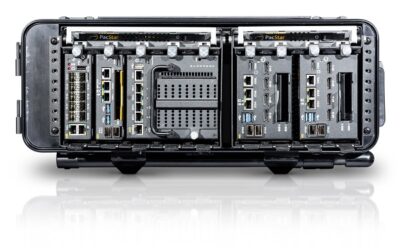Land Forces 2018: Solving Land 200, 75, 125
Australia’s programme for a new battlespace communications network under Land 200 is progressing through its second tranche with a third tranche of capability coming up for decision.
Alan Callaghan, President and Managing Director of Harris Defence Australia told MONCh that Tranche 2 has gone through its Initial Baseline Review (IBR) and System Readiness Review (SRR) and insisted that it is on track to the programme schedule towards the next milestones.
“We are working down the track with the vehicle integrators, Thales, Elbit and Rheinmetall. It is bringing a whole different bunch of folks together at one time, which is where we are at the moment,” Callaghan said. “Tranche 3 is about to go through government approval, they had an industry brief [on 4th September] and we expect an RFI to be issued in the next few months. That will followed by an RFT as it goes through the government two-pass process. Tranche 3 will be directed at further upgrading the tactical network and a degree of revisiting of the Tranche 1 and Tranche 2 configurations. It is really fielding that network, getting commonality across that network, extending it to all the vehicle types, refining what they have done.”
Defence told MONCh that Tranche 1 – the Battlefield Command System – includes Land 75 Phase 3.4 and 4 Work Package A providing a Battle Management System (BMS) and Tactical Communications Network (TCN), “both achieved FOC and are in the process of being closed down.”
It also includes Land 125 Phase 3A (BMS – dismounted), JP2072 Phase 2A (Raytheon EPLRS Tactical Data Radios), and JP2071 Combat Net Radios (Harris AN/PRC152 VHF and AN/PRC-150 HF).
“Under LAND 200 Tranche 1, Elbit Systems, as the prime systems integrator, delivered a Battle Group and Below Command, Control and Communications System for a brigade-sized group consisting of software, computers and a tactical data radio network,” Defence said.
Over 2,000 digital BMS are in use across Army from battalion to divisional level on a range of platforms including G-Wagon vehicles, PMV– medium; M113AS3 armoured personnel carriers; armed reconnaissance helicopters and Navy landing craft. Elbit was contracted in 2011 and therefore due to the rapid development of IT systems the programme has had to include software refreshes with each tranche.
Under Tranche 2 – Battlefield Command System project – the additional Land 75 Phase 4 work packages B-D have been combined with JP2072 Phase 3. This latter project is led by Harris Defence Australia in conjunction with subcontractor Boeing Defence Australia providing the network planning and management system (NPMS), which flows from the battalion level to the tactical level. Elbit Systems is a partner and the work being undertaken is to integrate the BMS onto the network. Callaghan said that, “it is still being worked on but is progressing well.”
He added that it is a technical process requiring a lot of trust and, “it is important that the BMS is optimised in its integration with the TCN. We have a long-term relationship with Elbit we worked with them on Tranche one and we are working very successfully with them on Tranche 2 and they will be the BMS provider for Tranche 3.”
Elbit Systems will give the BMS additional functionality as its progresses through the Tranches. For Harris, Callaghan said that Tranche 2 work will involve, “more capability, additional radios the ongoing upgrade of the network and the spreading of the network across the Army and bringing the whole network to a common level which will be Tranche 3.”
Defence said that under this second tranche BMS training will be embedded into the Army’s training, “through new portable tablets which will display hypothetical tactical exercises without troops (TEWT); and enhanced simulated software programmes to provide situational awareness data to the BMS to allow personnel to practise battlefield decision-making.”
The BMS will also be integrated into the M1A1 tanks, M88 armoured recovery vehicle, medium heavy cargo trucks (fitted with L200-1 kits), PMV-Light HAWKEI C2 and General Support variants, and the PMV – Medium BUSHMASTER C2 – Gateway. BMS software introduced in Tranche 1 will be enhanced. Harris will deliver its AN/PRC-152 VHF and AN/PRC-150 HF radios as part of the tactical communications network.
“Army successfully connected the BMS to US-operated coalition networks and this was validated on the coalition exercise Army warfighting assessment in 2016. BMS will also be a core application on the Mission Partner Environment being delivered under Joint Project 2221,” Defence said.
The contract for Tranche 2 was awarded in September 2017 so the companies are just one year in to a five-year contract. Tranche 3 will have its own timeline yet to be determined.
Tim Fish

























